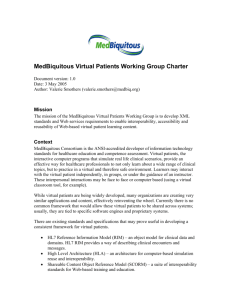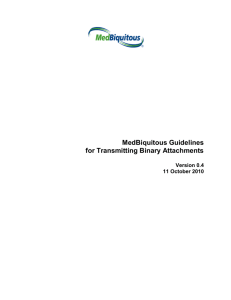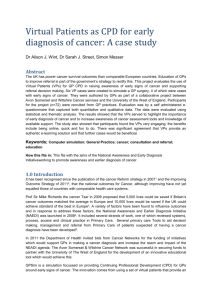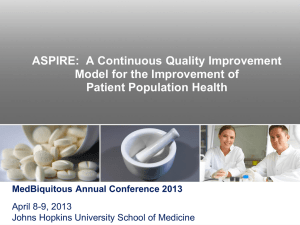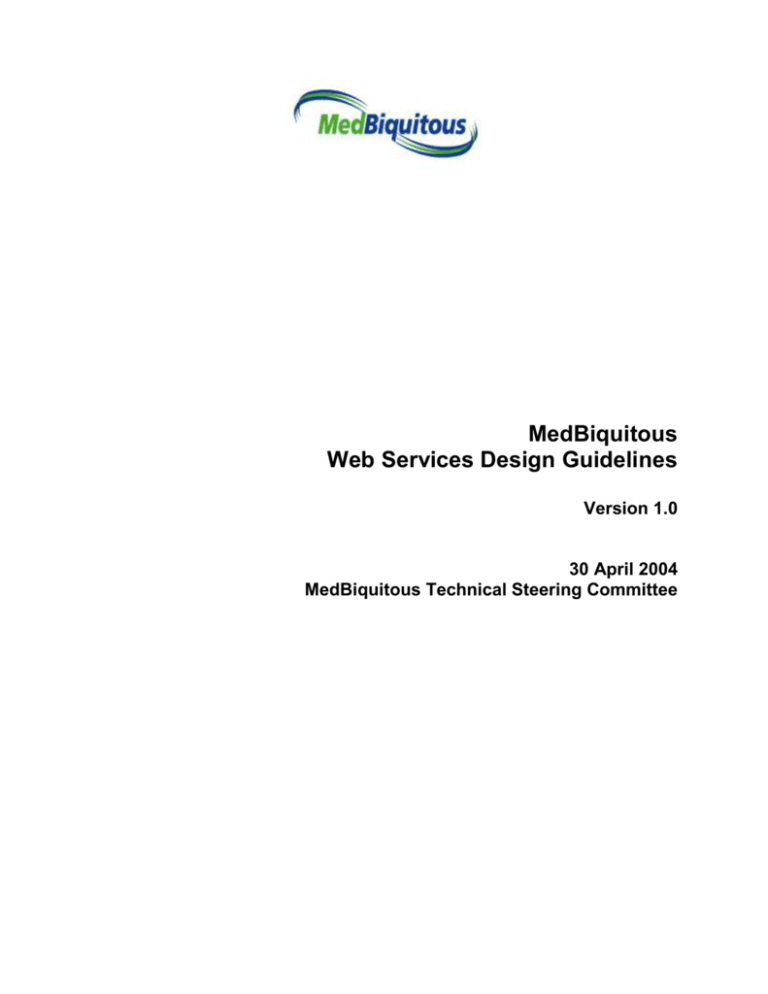
MedBiquitous
Web Services Design Guidelines
Version 1.0
30 April 2004
MedBiquitous Technical Steering Committee
MedBiquitous
Web Services Design Guidelines
Version:
1.0
Date: 30 Apr 2004
Revision History
Date
Version
Description
Author
17 Dec 2003
0.9
Draft for Technical Steering Committee
review
Scott Hinkelman
srh@us.ibm.com
17 Dec 2003
0.96
Namespace updates
Scott Hinkelman
srh@us.ibm.com
30 Apr 2004
1.0
Updated format
Valerie Smothers
valerie.smothers@medbiq.org
MedBiquitous Consortium, 2016
Page 2
MedBiquitous
Web Services Design Guidelines
Version:
1.0
Date: 30 Apr 2004
MedBiquitous Consortium XML Public License and Terms of Use
MedBiquitous XML (including schemas, specifications, sample documents, Web services description files, and
related items) is provided by the copyright holders under the following license. By obtaining, using, and or copying
this work, you (the licensee) agree that you have read, understood, and will comply with the following terms and
conditions.
The Consortium hereby grants a perpetual, non-exclusive, non-transferable, license to copy, use, display, perform,
modify, make derivative works of, and develop the MedBiquitous XML for any use and without any fee or royalty,
provided that you include the following on ALL copies of the MedBiquitous XML or portions thereof, including
modifications, that you make.
1.
2.
3.
Any pre-existing intellectual property disclaimers, notices, or terms and conditions. If none exist, the
following notice should be used: “Copyright © [date of XML release] MedBiquitous Consortium. All
Rights Reserved. http://www.medbiq.org”
Notice of any changes or modification to the MedBiquitous XML files.
Notice that any user is bound by the terms of this license and reference to the full text of this license in a
location viewable to users of the redistributed or derivative work.
In the event that the licensee modifies any part of the MedBiquitous XML, it will not then represent to the public,
through any act or omission, that the resulting modification is an official specification of the MedBiquitous
Consortium unless and until such modification is officially adopted.
THE CONSORTIUM MAKES NO WARRANTIES OR REPRESENTATIONS, EXPRESS OR IMPLIED, WITH
RESPECT TO ANY COMPUTER CODE, INCLUDING SCHEMAS, SPECIFICATIONS, SAMPLE
DOCUMENTS, WEB SERVICES DESCRIPTION FILES, AND RELATED ITEMS. WITHOUT LIMITING THE
FOREGOING, THE CONSORTIUM DISCLAIMS ANY IMPLIED WARRANTIES OF MERCHANTABILITY
OR FITNESS FOR A PARTICULAR PURPOSE AND ANY WARRANTY, EXPRESS OR IMPLIED, AGAINST
INFRINGEMENT BY THE MEDBIQUITOUS XML OF ANY THIRD PARTY PATENTS, TRADEMARKS,
COPYRIGHTS OR OTHER RIGHTS. THE LICENSEE AGREES THAT ALL COMPUTER CODES OR
RELATED ITEMS PROVIDED SHALL BE ACCEPTED BY LICENSEE “AS IS”. THUS, THE ENTIRE RISK
OF NON-PERFORMANCE OF THE MEDBIQUITOUS XML RESTS WITH THE LICENSEE WHO SHALL
BEAR ALL COSTS OF ANY SERVICE, REPAIR OR CORRECTION.
IN NO EVENT SHALL THE CONSORTIUM OR ITS MEMBERS BE LIABLE TO THE LICENSEE OR ANY
OTHER USER FOR DAMAGES OF ANY NATURE, INCLUDING, WITHOUT LIMITATION, ANY
GENERAL, DIRECT, INDIRECT, INCIDENTAL, CONSEQUENTIAL, OR SPECIAL DAMAGES, INCLUDING
LOST PROFITS, ARISING OUT OF ANY USE OF MEDBIQUITOUS XML.
LICENSEE SHALL INDEMNIFY THE CONSORTIUM AND EACH OF ITS MEMBERS FROM ANY LOSS,
CLAIM, DAMAGE OR LIABILITY (INCLUDING, WITHOUT LIMITATION, PAYMENT OF ATTORNEYS’
FEES AND COURT COSTS) ARISING OUT OF MODIFICATION OR USE OF THE MEDBIQUITOUS XML
OR ANY RELATED CONTENT OR MATERIAL BY LICENSEE.
LICENSEE SHALL NOT OBTAIN OR ATTEMPT TO OBTAIN ANY PATENTS, COPYRIGHTS OR OTHER
PROPRIETARY RIGHTS WITH RESPECT TO THE MEDBIQUITOUS XML.
THIS LICENSE SHALL TERMINATE AUTOMATICALLY IF LICENSEE VIOLATES ANY OF ITS TERMS
AND CONDITIONS.
MedBiquitous Consortium, 2016
Page 3
MedBiquitous
Web Services Design Guidelines
Version:
1.0
Date: 30 Apr 2004
Table of Contents
MedBiquitous Consortium XML Public License and Terms of Use
3
1.
Acknowledgements
5
2.
Scope
5
3.
Status
5
4.
Introduction
5
5.
Assumptions & Goals
5
5.1
5.2
5
5
Assumptions
Goals
6.
Notational Conventions
5
7.
Service Versioning and Namespace
6
8.
Service Filenames and Location
6
9.
Business Information Interfaces and Authoring
6
9.1
9.2
9.3
9.4
6
7
7
7
10.
Payload Authoring
Intentionality using WSDL Operation Names
Operation Granularity
Interface Statefulness
Uses of Current Web Services Technology
10.1
10.2
10.3
10.4
Transport
Point to Point Security
Protocol and Wire Format Binding
Service Definition and Authoring
10.4.1 ‘What’ WSDL Perspective
10.5
Business Process
10.6
Discovery
10.7
Binary Information Transmit
7
7
7
7
9
10
12
12
12
11.
References
12
A1.
Common Fault Types Formal W3C XML Schema
13
A2.
Common Fault Web Services Messages
13
MedBiquitous Consortium, 2016
Page 4
MedBiquitous
Web Services Design Guidelines
Version:
1.0
Date: 30 Apr 2004
Web Services Design Guidelines
1.
Acknowledgements
These guidelines are based on a submission from Scott Hinkelman of IBM. Joel Farrell of IBM and Darin McBeath
of Elsevier Science also contributed to this document.
2.
Scope
This document suggests best practices, high level guidelines, and recommendations that should be followed when
defining MedBiquitous Web services. It defines the approach for concrete realization within a Web services
environment.
3.
Status
This document is considered part of MedBiquitous release 1.0. MedBiquitous welcomes your suggestions about this
document.
4.
Introduction
MedBiquitous is committed to defining a Web services-based environment to support the exchange of
MedBiquitous payload information. This document is focused on recommendations and guidelines for Web services
design based on current Web services specifications/standards. It is expected that the next release of this document
will address increased emerging technology and directions. It should be realized that the content of this document is
closely tied to the date/version due to the evolving Web services technology, and revisions will be required for the
foreseeable future.
5.
Assumptions & Goals
5.1
Assumptions
Readers have an understanding of the base de facto Web Services technologies.
Readers have an understanding of the state of the industry with regard to the current stability and continual
evolution of such technology.
Readers have an understanding of interface definition paradigms and the role in distributed computing.
5.2
Goals
The primary goal of this document is to provide the initial guidelines for development and implementation of
MedBiquitous Web services. This document expresses guidelines for consistency based in real world experience for
the purpose of initially moving forward with Web services.
It should be noted that WS-I.org's basic profile [WSIBP] provides a wealth of guidelines focused on achieving
interoperability and should be considered along with this document. However, some of WS-I's basic profile is a
clarification of Web service specifications targeted for Web services infrastructure developers and is not directly
relevant to MedBiquitous Web Services guidelines. Also, there are sections within the WS-I basic profile that
identify inconsistencies between the WSDL1.1 [WSDL] specification and its W3C XML Schema [XMLSchema1],
which are not referenced within this document.
Where relevant, the WS-I information is referenced as appropriate, but the WS-I BP 1.0 should be considered
required reading. This document goes beyond the space of WS-I and addresses guidelines for items such as common
faults for all services, which are needed to accommodate a robust Web services approach while considering issues
such as the payload design approach, etc.
6.
Notational Conventions
The keywords "MUST", "MUST NOT", "REQUIRED", "SHALL", "SHALL NOT", "SHOULD", "SHOULD
NOT", "RECOMMENDED", "MAY", and "OPTIONAL" in this document are to be interpreted as described in
MedBiquitous Consortium, 2016
Page 5
MedBiquitous
Web Services Design Guidelines
Version:
1.0
Date: 30 Apr 2004
RFC2119 [RFC2119]. Namespace URIs (of the general form "some-URI") represents some application-dependent
or context-dependent URI [URI] as defined in [RFC2396].
7.
Service Versioning and Namespace
The MedBiquitous namespace URIs are of a URL scheme. As such, nothing is guaranteed about re-referencing the
namespace URL at runtime, and the schema location is given by the schemaLocation attribute of xsd:import
element.
MedBiquitous uses the namespace name to represent versioning of the business content, with an initial version of 1.
Any structural or syntactic changes to the XML Schema file requires the version number to change.
Example of a member workgroup namespace name:
http://ns.medbiq.org/member/v1/
The namespace name representing MedBiquitous Web services will be formulated by a consistent modification of
the MedBiquitous business content namespace scheme, as defined in the MedBiquitous XML Schema Design
Guidelines 1.0. A service namespace name will be the same as the schemas for the business content, with service
inserted before the version number.
An example of the matching service namespace:
http://ns.medbiq.org/member/service/v1/
8.
Service Filenames and Location
The MedBiquitous service binding convention utilizes a wrapped document-literal approach, a business-content
wrapped model (see protocol section), where the business content schemas defined by the business working groups
are imported by the schema defining the service operations.
The MedBiquitous wrapper schemas will be defined within the associated service namespace.
The wrapper file names will follow the pattern (workgroup)types.xsd.
Example of a member workgroup namespace name:
membertypes.xsd
The associated files would available in a v1 directory which will have an index.html document that contains
links to the schemas and to any specifications. The associated files would be
http://ns.medbiq.org/member/v1/member.xsd
http://ns.medbiq.org/member/service/v1/membertypes.xsd
9.
Business Information Interfaces and Authoring
9.1
Payload Authoring
MedBiquitous will avoid defining business content in the <wsdl:type> structure and keep all business type
information authored independently from the Web services interface specification documents. This will help enable
the business payload development by avoiding the details of the underlying Web services technology layer.
MedBiquitous payload xsd's will be imported indirectly into MedBiquitous WSDL files through the
(workgroup)types.xsd files. Business content will not be authored within WSDL files.
MedBiquitous Consortium, 2016
Page 6
MedBiquitous
Web Services Design Guidelines
Version:
1.0
Date: 30 Apr 2004
9.2
Intentionality using WSDL Operation Names
The current MedBiquitous business content design approach is to design XML documents within a project scope
without providing any information on how the documents will be used (non-contextual information modeling). For
example, the Member Profile schema provides a method of describing a member record but excludes information on
what is to be done with the member record. WSDL1.1's abstract layer allows Web services designers to express how
the documents will be used through named operations. Operations provide the usage context by expressing the
intentionality (verbs). This is the predominant situation in MedBiquitous. MedBiquitous will use WSDL operation
names to express intentionality in this case, with the operations names used as the root element of input messages
defined within the (workgroup)types.xsd files.
9.3
Operation Granularity
In order to avoid fragile Web service interfaces, consideration should be given to defining general operations on
service interfaces before defining highly specific operations. An example of this is to prefer CRUD (Create, Read,
Update, Delete) operations over operations such as "createCardilologist()" if appropriate. The preferred/common
payload design authoring in MedBiquitous is to specify a robust type-base document using a single root element
(Venetian Blind), which can be used for several operations.
This design lends towards WSDL1.1 <part> elements which reference an entire document via the wrapped element
within the (workgroup)types.xsd file. This approach results in the WSDL <message> having a single <part>, leading
to a natural approach toward generic interface operations across the entire multi-usage payload. This shields the
interface from change over time, however at the expense of constraint checking within the business logic. To help
mitigate the impact on business logic for these type of interfaces, MedBiquitous will define consistent 'business rule'
faults for all WSDL <operations> (discussed further in this document). MedBiquitous business interface designs
will favor generic service operations before highly typed specific operations.
9.4
Interface Statefulness
The current state of the Web services art is that there is no inherent architectural state mechanism. Several
underlying transports provide state management capabilities, but there is no formalism within context of the Web
services principals of separation of description and transport (bindings). MedBiquitous will design business
interfaces with no reliance on statefulness.
10.
Uses of Current Web Services Technology
10.1
Transport
There is only one formal transport binding (HTTP) defined for Web services assuming the SOAP protocol. For
maximum interoperability, MedBiquitous will use HTTP for transport. This is consistent with WS-I.org Board
Approval Draft 1.0 section 4.3 HTTP Versions. MedBiquitous will use HTTP/1.0/1.1 for transport binding.
10.2
Point to Point Security
Initial implementations of MedBiquitous Web services will be largely point-to-point. For these environments, SSL
can be used for mutual or one-way authentication and for data encryption support for confidentiality between two
points. In environments beyond point-to-point, proof of an original subject's authentication and authorization
credentials will not propagate across points/nodes and other Web services will need to be used to accomplish
security goals. This is consistent with WS-I.org Board Approval Draft 1.0 section 7.1 Use of HTTPS. MedBiquitous
will use HTTPS transport-level security for confidentiality support.
10.3
Protocol and Wire Format Binding
There is only one formal protocol binding for WSDL1.1 (SOAP1.1). MedBiquitous will utilize this protocol
binding. MedBiquitous will use SOAP1.1 for interaction protocol.
WS-I.org has identified problems with several binding usages concerning the soapbind namespace attribute.
MedBiquitous is concerned with the document/literal usage, where the namespace attribute should not be specified.
This is consistent with the document/literal discussion in WS-I.org Board Approval Draft 1.0 section5.6.12
MedBiquitous Consortium, 2016
Page 7
MedBiquitous
Web Services Design Guidelines
Version:
1.0
Date: 30 Apr 2004
Namespace and soap:bind elements.
A wsdl:binding that contains a soapbind:binding element whose style attribute is either missing or specified with a
value of document and whose set of soapbind:body elements all specify the use="literal" attribute constitute a
document/literal binding. MedBiquitous' current direction defining type-oriented payload documents with single
root elements lends itself toward defining WSDL document/literal bindings (RPC/literal bindings for example are
restricted to referring to wsdl:part elements that have been defined using the type attribute). However, conclusions
within WS-I.org are largely interpreted to indicate that payload uniqueness is required in order to distinguish
payload intention at runtime. In order to facilitate this, and continue to allow the MedBiquitous workgroups to not
be concerned with the low level infrastructure of Web services, MedBiquitous will deploy a ‘wrapped’
Document/Literal style, where the MedBiquitous content payloads are wrapped with request/response operation
wrapper elements defined in a (workgroup)types.xsd file.
For the following examples, a fictitious MedBiquitous workgroup is used called ‘What.’ The following example
typifies a MedBiquitous business content payload schema:
[1] <?xml version="1.0" encoding="UTF-8"?>
[2] <xs:schema targetNamespace="http://ns.medbiq.org/what/v1/"
xmlns:xs="http://www.w3.org/2001/XMLSchema"
xmlns:w="http://ns.medbiq.org/what/v1/"
elementFormDefault="qualified" attributeFormDefault="unqualified">
[3]
<xs:complexType name="WhatType">
[4]
<xs:sequence>
[5]
<xs:element name="A" maxOccurs="unbounded"/>
[6]
<xs:element name="B" maxOccurs="unbounded"/>
[7]
</xs:sequence>
[8]
</xs:complexType>
[9]
<xs:element name="Whats" type="w:WhatsType"/>
[10]
<xs:complexType name="WhatsType">
[11]
<xs:sequence>
[12]
<xs:element name="What" type="w:WhatType"
maxOccurs="unbounded"/>
[13]
</xs:sequence>
[14]
</xs:complexType>
[15] </xs:schema>
Lines (001) to (002) define the schema construct, namespace names, etc.
Lines (003) to (008) define a global complex type. Line (009) defines a single root element within the namespace of
type defined on lines (010) to (014). Local elements are defined of a global type, such as on line (012).
The following is the matching whattypes.xsd wrapper schema:
[1] <?xml version="1.0" encoding="UTF-8"?>
[2] <xs:schema targetNamespace="ns.medbiq.org/what/service/v1/"
xmlns:xs="http://www.w3.org/2001/XMLSchema"
xmlns:w="ns.medbiq.org/what/v1/"
xmlns:ws="ns.medbiq.org/what/service/v1/"
elementFormDefault="qualified" attributeFormDefault="unqualified">
[3]
<xs:import namespace="ns.medbiq.org/what/v1"
schemaLocation="./what.xsd"/>
[4]
<xs:element name="operation1">
MedBiquitous Consortium, 2016
Page 8
MedBiquitous
Web Services Design Guidelines
Version:
1.0
Date: 30 Apr 2004
[5]
<xs:complexType>
[6]
<xs:sequence>
[7]
<xs:element ref="w:Whats"/>
[8]
</xs:sequence>
[9]
</xs:complexType>
[10]
</xs:element>
[11]
<xs:element name="operation1Response">
[12]
<xs:complexType>
[13]
<xs:sequence>
[14]
<xs:element ref="w:Whats"/>
[15]
</xs:sequence>
[16]
</xs:complexType>
[17]
</xs:element>
[18] </xs:schema>
Lines (001) to (002) define the schema construct, namespaces, etc. The namespace name of the wrapper schema is
the service namespace name on line (002).
Line (003) xs imports the what business content schema.
Lines (004) to (010) define a global element request wrapper for a WSDL operation specified with a name attribute
of “Operation1”. Line (007) defines a local element reference to the root business content element imported on line
(003).
Lines (011) to (017) define a global element response wrapper for a WSDL operation specified with a name attribute
of “Operation1”. Line (014) defines a local element reference to the root business content element imported on line
(003).
The operation wrapper elements will be in lower camel case to facilitate easy programmatic implementation. The
operation wrapper elements will reside in a separate schema within the service namespace (see section on
namespace/files names/ versioning). This will define the content structure needed for the MedBiquitous binding.
It should be realized that the wrapping element, reflective of each WSDL operation name, could be considered to
essentially add definition to the payloads of MedBiquitous messages. Authoring of business content within the
(workgroup)types.xsd files is restricted to defining structural associations of imported schema, with the primary
intention to facilitate use of 3rd party schema which are a required part of the service but not appropriate to be
integrated with the core MedBiquitous business content schemas. No first class business content will be introduced
as part of the (workgroup)types.xsd files.
The wrapper schemas, one per service, will consist of the request and response elements for all operations defined
within the service. The WSDL files will import this schema, and the core business content schema will be imported
from the (workgroup)types.xsd file.
Concerning 3 rd party schema locations, xsds for these schemas will be copied to the MedBiquitous schema server
and then referenced by the schemaLocation attribute in order to remove dependency on 3 rd party infrastructure.
10.4
Service Definition and Authoring
Web services define an IDL-based environment where the central gravity point is that of a service definition. It is
well recognized with little contention that WSDL is the specification that will pervasively enable description of a
‘service’. MedBiquitous must utilize WSDL1.1.
WSDL provides three logical perspectives on a Web service description:
MedBiquitous Consortium, 2016
Page 9
MedBiquitous
Web Services Design Guidelines
Version:
1.0
Date: 30 Apr 2004
What (business interface issues)
How (binding issues)
Where (service location issues)
10.4.1 ‘What’ WSDL Perspective
MedBiquitous will define 'soap:binding' locations with only one associated Port. This is consistent with WS-I.org
Board Approval Draft 1.0 section 5.6.9 Multiple Ports on an endPoint.
The current Web services IDL mechanism via WSDL1.1 defines no implicit distinguished operational faults at the
abstract layer. (CORBA, for example, has common implied errors that the ORB may raise). However, all
invocations may fail for a common set of reasons that need exposure to the invoking business logic. MedBiquitous
defines a base set of common Web services Faults. The namespace name URI is:
http://ns.medbiq.org/commonservices/commonfaultmessages/v1/
This namespace must be imported, and declared on all MedBiquitous WSDL operations.
In the following example the common faults are declared on lines (214), (215), and (216). Refer to the appendix
sections for complete xsd schema(s) to be used for MedBiquitous common Web services Faults.
[205] <operation name="DeleteMember">
[206] <documentation>Persistently creates a member profile within the
default IDContext of the service implementation from the supplied
member data associated with the supplied identifier. The provided
contextualized identifier is returned.</documentation>
[207] <input message="tns:IdentifiedMemberDataMessage"/>
[208] <output message="tns:MemberContextualizedIDMessage"/>
[209] <fault name="IDCreationNotSupportedFault"
message="tns:IDCreationNotSupportedMessage"/>
[210] <fault name="InvalidIDFault" message="tns:InvalidIDMessage"/>
[211] <fault name="NoDefaultIDContextFault"
message="tns:NoDefaultIDContextMessage"/>
[212] <fault name="IDAlreadyExistsFault"
message="tns:IDAlreadyExistsMessage"/>
[213] <fault name="MemberDataMatchFault"
message="tns:MemberDataMatchMessage"/>
[214] <fault name="ServiceOperationNotCurrentlyAvailableFault"
message="cfm:ServiceOperationNotCurrentlyAvailableFaultMessage"/>
[215] <fault name="BusinessRuleFault"
message="cfm:BusinessRuleFaultMessage"/>
[216] <fault name="UnknownFault" message="cfm:UnknownFaultMessage"/>
[217] </operation>
MedBiquitous common WSDL Faults are defined in the WebServicesCommonFaults.wsdl file. This file has a
dependency on the WebServicesCommonFaultTypes.xsd file, which defines a base set of common Web services
Fault types. The namespace name URI is:
http://ns.medbiq.org/commonservices/commonfaulttypes/v1/
Beyond specifying the binding as Doc/Lit within the how perspective of WSDL, the wrapping aspect largely falls
into the ‘what’ perspective. The following example shows the ‘what’ WSDL perspective of the fictitious ‘what’
MedBiquitous workgroup consistently with the discussions in the protocol section of this document.
MedBiquitous Consortium, 2016
Page 10
MedBiquitous
Web Services Design Guidelines
Version:
1.0
Date: 30 Apr 2004
[1] <?xml version="1.0" encoding="UTF-8"?>
[2] <definitions xmlns="http://schemas.xmlsoap.org/wsdl/"
xmlns:xs="http://www.w3.org/2001/XMLSchema"
xmlns:tns="ns.medbiq.org/what/service/v1"
xmlns:cfm="ns.medbiq.org/commonservices/commonfaultmessages/v1"
targetNamespace="ns.medbiq.org/what/service/v1"
name="MedBiquitous What Service Example Version 1">
[3]
<import
namespace="ns.medbiq.org/commonservices/commonfaultmessages/v1"
location="./WebServicesCommonFaultMessages.wsdl"/>
[4]
<types>
[5]
<xs:schema targetNamespace="ns.medbiq.org/what/service/v1">
[6]
<xs:include schemaLocation="./whattypes.xsd"/>
[7]
</xs:schema>
[8]
</types>
[9]
<message name="Operation1InputMessage">
[10]
<part name="Wrapper" element="tns:operation1"/>
[11]
</message>
[12]
<message name="Operation1OutputMessage">
[13]
<part name="Wrapper" element="tns:operation1Response"/>
[14]
</message>
[15]
<message name="Fault1Message">
[16]
</message>
[17]
<portType name="WhatPortType">
[18]
<operation name="Operation1">
[19]
<input message="tns:Operation1InputMessage"/>
[20]
<output message="tns:Operation1OutputMessage"/>
[21]
<fault name="Fault1" message="tns:Fault1Message"/>
[22]
<fault name="ServiceOperationNotCurrentlyAvailableFault"
message=
"cfm:ServiceOperationNotCurrentlyAvailableFaultMessage"/>
[23]
<fault name="BusinessRuleFault"
message="cfm:BusinessRuleFaultMessage"/>
[24]
<fault name="UnknownFault"
message="cfm:UnknownFaultMessage"/>
[25]
</operation>
[26]
</portType>
[27] </definitions>
Lines (001) to (002) define the definitions, namespaces, etc. The target namespace name follows the consistent
modification of the business content namespace name. The namespace name of the common web services fault
messages is declared.
Line (003) WSDL imports the common web services fault message definitions, which are defined in a different
(common) namespace.
The WSDL types section from line (004) to (008) defines an W3C XML Schema in the service’s target namespace
name in order to xs include the whattypes.xsd wrapper schema on line (006), which is defined in the same
namespace.
Lines (009) to (011) define an input message for the Operation1 operation. A single part, named ‘Wrapper’, is
defined on line (010) which references the request global element for the operation in the included schema.
MedBiquitous Consortium, 2016
Page 11
MedBiquitous
Web Services Design Guidelines
Version:
1.0
Date: 30 Apr 2004
Lines (012) to (014) define an output message for the Operation1 operation. A single part, named ‘Wrapper’, is
defined on line (013) which references the response global element for the operation in the included schema.
Line (015) defines a service-specifc fault message.
Lines (017) to (026) define the service portType. An operation is defined from line (018) to (025) which references
the input and output messages on lines (019) and (020). Line (021) specifies the service-specifc fault. Line (022) to
line (024) sepecify the common faults from the import.
10.5
Business Process
MedBiquitous will ultimately move toward defining explicit business process definitions. However, it should
realized that simple stand-alone Web services invocations can be thought of as "implicit business processes."
MedBiquitous can define/release initial sets of Web services, which can be used within such implicit processes
without the initial focus on definition of "explicit processes" which use a formal declarative language. Currently
there are several efforts in the business process space including the W3C Choreography workgroup, the Business
Process Execution Language for Web Services in OASIS, and ebXML’s BPSS. It is currently an area of immaturity
and needs monitoring, but there is value to be currently gained by focusing on initial sets of service definitions
outside of formal definitions for business process.
10.6
Discovery
Concerning registration mechanisms, formal tools for service descriptions, such as UDDI or ebXML RegRep, will
not be included in the initial phases of MedBiquitous’s Web services, as it has not been clear of the requirements (if
any) for such. Decisions on utilizing a formal registry, when/if and hosting will be address later.
Publication and hosting of service definitions will be accommodated on the medbiq.org web site. A taxonomy will
be defined by the TSC to accommodate the separation of the standard MedBiquitous abstract (interface) layer
WSDL files and associated member-specific binding implementation files, accommodating a single point of entry
and simple central registry for service discovery. (Note: This implies space and id [FTP ?, etc] management by the
MedBiquitous staff for member organizations. An alternate approach is hosting binding details on each member
organizations site with the disadvantage of a single point of entry for service discovery).
Concerning service discovery, MedBiquitous will initially rely on manual development time (static) discovery by
developers into the single point of entry of the medbiq.org service taxonomy. There will be no runtime dynamic
binding API dependency on a registry mechanism. When a member organization wants to call a Web service
provided by another, the developer searches the taxonomy provided on medbiq.org for an implementation by the
member with which he needs to interact, and downloads the implementation WSDL, which drags along the abstract
interface WSDL MedBiquitous standard. The developer creates a client that calls the Web service.
10.7
Binary Information Transmit
MedBiquitous will leverage the SOAP With Attachments [SWA] specification for transmitting binary information.
11.
References
[keywords]
S. Bradner, "Key words for use in RFCs to Indicate Requirement Levels," RFC 2119, Harvard University, March
1997, http://www.ietf.org/rfc/rfc2119.txt
[URI]
T. Berners-Lee, R. Fielding, L. Masinter, "Uniform Resource Identifiers (URI): Generic Syntax," RFC 2396,
MIT/LCS, U.C. Irvine, Xerox Corporation, August 1998, http://www.ietf.org/rfc/rfc2396.txt
[XPath]
MedBiquitous Consortium, 2016
Page 12
MedBiquitous
Web Services Design Guidelines
Version:
1.0
Date: 30 Apr 2004
XML Linking Language (XLink) Version 1.0, http://www.w3.org/TR/2001/REC-xlink-20010627/
[XSLT]
XSL Transformations (XSLT) Version 1.0, http://www.w3.org/TR/xslt
[XMLNamespace]
W3C Recommendation, Namespaces in XML, http://www.w3.org/TR/1999/REC-xml-names-19990114
[XML]
Extensible Markup Language (XML) 1.0 (Second Edition), http://www.w3.org/TR/REC-xml
[XMLSchema1]
W3C Recommendation, XML Schema Part 1: Structures, http://www.w3.org/TR/2001/REC-xmlschema-120010502/
[XMLSchema2]
W3C Recommendation, XML Schema Part 2: Datatypes, http://www.w3.org/TR/2001/REC-xmlschema-220010502/
[WSIBP]
Web Services Interoperability Basic Profile 1.0a, http://ws-i.org/Profiles/Basic/2003-08/BasicProfile-1.0a.html
[RFC2045]
A Multipurpose Internet Mail Extensions (MIME) Part One, Format of Internet Message Bodies,
http://www.ietf.org/rfc/rfc2045.txt?number=2045
[RFC2046]
A Multipurpose Internet Mail Extensions (MIME) Part Two: Media Types,
http://www.ietf.org/rfc/rfc2046.txt?number=2046
[SWA]
W3C Note, "SOAP Messages with Attachments", December 2000
[MedBiquitous]
MedBiquitous, Collaborative technologies for medical education, http://www.medbiq.org/
[WSDL]
W3C Note, Web services Description Language 1.1, http://www.w3.org/TR/wsdl
A1.
Common Fault Types Formal W3C XML Schema
<?xml version="1.0" encoding="UTF-8"?>
<xs:schema
targetNamespace="ns.medbiq.org/commonservices/commonfaulttypes/v1"
xmlns:cft="ns.medbiq.org/commonservices/commonfaulttypes/v1"
xmlns:xs="http://www.w3.org/2001/XMLSchema"
elementFormDefault="qualified" attributeFormDefault="unqualified">
<xs:element name="Fault" type="cft:FaultType"/>
<xs:complexType name="FaultType">
<xs:sequence>
<xs:element name="description" type="xs:string" minOccurs="0"
maxOccurs="unbounded"/>
</xs:sequence>
</xs:complexType>
</xs:schema>
A2.
Common Fault Web Services Messages
<definitions xmlns="http://schemas.xmlsoap.org/wsdl/"
xmlns:xs="http://www.w3.org/2001/XMLSchema"
xmlns:cft="http://ns.medbiq.org/commonservices/commonfaulttypes/v1/"
xmlns:cfm="http://ns.medbiq.org/commonservices/commonfaultmessages/v1/"
targetNamespace=
MedBiquitous Consortium, 2016
Page 13
MedBiquitous
Web Services Design Guidelines
Version:
1.0
Date: 30 Apr 2004
"http://ns.medbiq.org/commonservices/commonfaultmessages/v1/"
name="WebServicesCommonFaultMessages Version 1">
<types>
<xs:schema
targetNamespace="ns.medbiq.org/commonservices/commonfaulttypes/v1">
<xs:include schemaLocation="./WebServicesCommonFaultTypes.xsd"/>
</xs:schema>
</types>
<message name="ServiceOperationNotCurrentlyAvailableFaultMessage">
<documentation>The operation on this service is currently not
available.</documentation>
<part name="FaultPart" type="cft:FaultType"/>
</message>
<message name="BusinessRuleFaultMessage">
<documentation>The service implementation has determined that the
supplied business information is insufficient to satisfy a business
rule.</documentation>
<part name="FaultPart" type="cft:FaultType"/>
</message>
<message name="UnknownFaultMessage">
<documentation>The service implementation has determined that no
other declared fault is appropriate for a failure
condition.</documentation>
<part name="FaultPart" type="cft:FaultType"/>
</message>
</definitions>
MedBiquitous Consortium, 2016
Page 14

